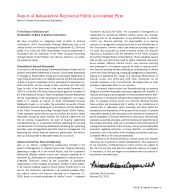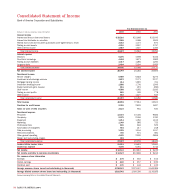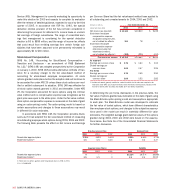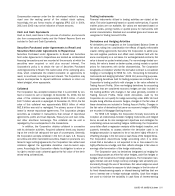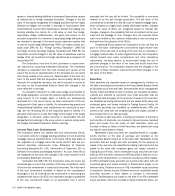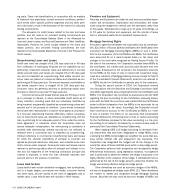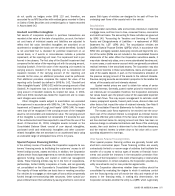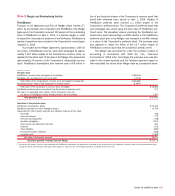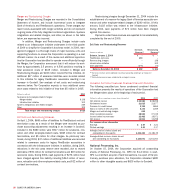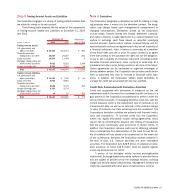Bank of America 2004 Annual Report Download - page 102
Download and view the complete annual report
Please find page 102 of the 2004 Bank of America annual report below. You can navigate through the pages in the report by either clicking on the pages listed below, or by using the keyword search tool below to find specific information within the annual report.
$10.0 billion. There was no material impact to Net Income or Tier 1
Capital as a result of the adoption of FIN 46 or the subsequent
deconsolidation of this entity, and prior periods were not restated. In
December 2003, the FASB issued FASB Interpretation No. 46
(Revised December 2003), “Consolidation of Variable Interest
Entities, an interpretation of ARB No. 51” (FIN 46R), which is an
update of FIN 46. The Corporation adopted FIN 46R as of March 31,
2004. Adoption of this rule did not have a material impact on the
Corporation’s results of operations or financial condition. For addi-
tional information on VIEs, see Note 8 of the Consolidated Financial
Statements.
On December 12, 2003, the American Institute of Certified
Public Accountants issued Statement of Position No. 03-3,
“Accounting for Certain Loans or Debt Securities Acquired in a
Transfer” (SOP 03-3). SOP 03-3 requires acquired impaired loans for
which it is probable that the investor will be unable to collect all
contractually required payments receivable to be recorded at the
present value of amounts expected to be received and prohibits
carrying over or creation of valuation allowances in the initial
accounting for these loans. SOP 03-3 is effective for loans acquired
in fiscal years beginning after December 31, 2004. SOP 03-3 is not
expected to have a material impact on the Corporation’s results of
operations or financial condition.
On March 9, 2004, the Securities and Exchange Commission
(SEC) issued Staff Accounting Bulletin No. 105, “Application of
Accounting Principles to Loan Commitments” (SAB 105), which spec-
ifies that servicing assets embedded in commitments for loans to be
held-for-sale should be recognized only when the servicing asset has
been contractually separated from the associated loans by sale or
securitization. The adoption of SAB 105 is effective for commitments
entered into after March 31, 2004. The adoption of SAB 105 had no
material impact on the Corporation’s results of operations or financial
condition.
On March 18, 2004, the Emerging Issues Task Force (EITF)
issued EITF 03-1, “The Meaning of Other-Than-Temporary Impairment
and Its Application to Certain Investments” (EITF 03-1). EITF 03-1
provides recognition and measurement guidance regarding when
impairments of equity and debt securities are considered other-than-
temporary thereby requiring a charge to earnings, and also requires
additional annual disclosures for investments in unrealized loss posi-
tions. The additional annual disclosure requirements were previously
issued by the EITF in November 2003 and were effective for the
Corporation for the year ended December 31, 2003. In September
2004, the FASB issued FASB Staff Position (FSP) EITF 03-1-1, which
delays the recognition and measurement provisions of EITF 03-1
pending the issuance of further implementation guidance. We are
currently evaluating the effect of the recognition and measurement
provisions of EITF 03-1.
In the third quarter of 2004, the Corporation adopted FSP No.
FAS 106-2, “Accounting and Disclosure Requirements Related to the
Medicare Prescription Drug, Improvement and Modernization Act of
2003” (FSP No. 106-2), which superseded FSP No. FAS 106-1. FSP
No. 106-2 provides authoritative guidance on accounting for the fed-
eral subsidy and other provisions of the Medicare Prescription Drug,
Improvement and Modernization Act of 2003 (the Medicare Act). The
effects of these provisions were recognized prospectively from July 1,
2004. A remeasurement on that date resulted in a reduction of $53
million in the Corporation’s accumulated postretirement benefit obli-
gation. In addition, the Corporation’s net periodic benefit cost for
other postretirement benefits has decreased by $15 million for 2004
as a result of the remeasurement.
On December 16, 2004, the FASB issued Statement of Financial
Accounting Standards (SFAS) No. 123 (revised 2004) “Share-based
Payment” (SFAS 123R) which eliminates the ability to account for
share-based compensation transactions using Accounting Principles
Board (APB) Opinion No. 25, “Accounting for Stock Issued to
Employees,” (APB 25) and generally requires that such transactions
be accounted for using a fair value-based method with the resulting
compensation cost recognized over the period that the employee is
required to provide service in order to receive their compensation.
SFAS 123R also amends SFAS No. 95, “Statement of Cash Flows,”
requiring the benefits of tax deductions in excess of recognized com-
pensation cost to be reported as a financing cash flow, rather than
as an operating cash flow as currently required. The Corporation
plans to adopt SFAS 123R beginning July 1, 2005, using the modi-
fied-prospective method. The Corporation adopted the fair value-
based method of accounting for stock-based employee compensation
prospectively as of January 1, 2003, and as a result, adoption of
SFAS 123R is not expected to have a material impact on the
Corporation’s results of operations or financial condition.
On December 21, 2004, the FASB issued FSP No. 109-2,
“Accounting and Disclosure Guidance for the Foreign Earnings
Repatriation Provision within the American Jobs Creation Act of
2004” (FSP No. 109-2). FSP No. 109-2 provides accounting and
disclosure guidance for the foreign earnings repatriation provision
within the American Jobs Creation Act of 2004 (the Act). The Act,
signed into law on October 22, 2004, provided U.S. companies with
the ability to elect to apply a special one-time tax deduction equal to
85 percent of certain earnings remitted from foreign subsidiaries,
provided certain criteria are met. Much of the detailed guidance
about how this special deduction will operate has yet to be issued
by the U.S. Department of the Treasury and the Internal Revenue
BANK OF AMERICA 2004 101






